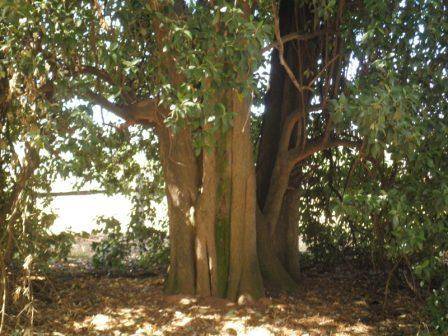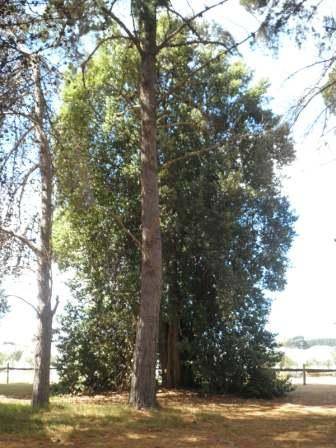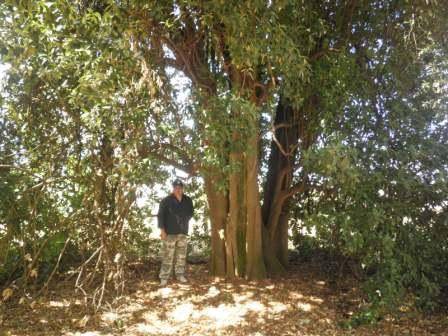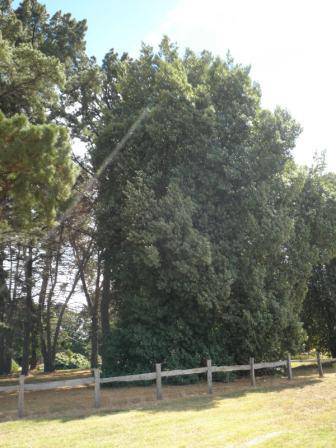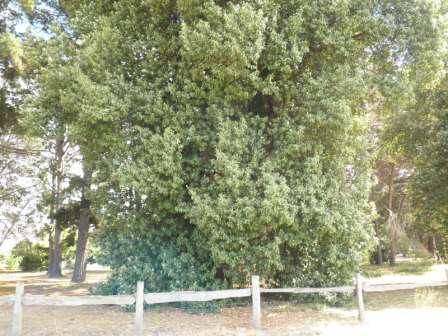| Back to search results » | Back to search page » |
|
Lagunaria patersonia subsp. patersonia
Other NamesCow Itch Tree , Norfolk Hibiscus (on Norfolk Island) , White Oak , Sally Wood (on Lord Howe Island) , Pyramid Tree LocationWerribee Park Mansion, 320 K Road,, WERRIBEE VIC 3030 - Property No T12173
File NumberT12173LevelState |
|
Statement of Significance
What is significant?
Contribution to landscape of historic garden
Outstanding size
Aesthetic value
Historical value
Outstanding example of species
Outstanding size
Aesthetic value
Historical value
Outstanding example of species
This Norfolk Hibiscus (Lagunaria patersonia subsp. patersonia), located on the East boundary of Werribee Park Mansion garden represents a typical 1860's style of planting which used this native evergreen tree. Evidence of this style is found around the original Chirnside homestead on the Werribee River bank. This specimen was selected and planted circa 1877 by the gardeners employed by Thomas Chirnside at Werribee Park. The Chirnside Family's contribution to Victoria's pastoral and agricultural growth is notable as leaders and pioneers of the colony's pastoral industry. Their vast land holdings in Victoria, New South Wales, South Australia and Queensland made them one of the wealthiest families in the colony. The grandeur of their influence and wealth is reflected in their opulent Roman Renaissance Revival style mansion at Werribee Park and is stately garden.
This specimen's outstanding size is notable. It has a height above the botanically described height for the species of 15 metres (R. Spencer, p.386). and has developed five tall leader trunks. Even though a native tree, it is typical of the type of silhouette and architectural form that nineteenth century garden enthusiasts with large rural estates collected and introduced to make their estate gardens feel more 'European' in design.
Measurements: 12/02/2012
Spread (m): E-W:15; N-S 17
Girth (m): 5.2 at 300mm above ground
Height (m): 21.3
Estimated Age (yrs): 135
Condition: Good
Measurements: 08/12/2022
Spread (m): E-W 16.4, N-S 16.4
Girth (m): 5.1 at ground
Height (m): 20.2
This specimen's outstanding size is notable. It has a height above the botanically described height for the species of 15 metres (R. Spencer, p.386). and has developed five tall leader trunks. Even though a native tree, it is typical of the type of silhouette and architectural form that nineteenth century garden enthusiasts with large rural estates collected and introduced to make their estate gardens feel more 'European' in design.
Measurements: 12/02/2012
Spread (m): E-W:15; N-S 17
Girth (m): 5.2 at 300mm above ground
Height (m): 21.3
Estimated Age (yrs): 135
Condition: Good
Measurements: 08/12/2022
Spread (m): E-W 16.4, N-S 16.4
Girth (m): 5.1 at ground
Height (m): 20.2
Access: Unrestricted
Classified: 28/05/2012
Classified: 28/05/2012
How is it significant?
Contribution to landscape of historic garden
Outstanding size
Aesthetic value
Historical value
Outstanding example of species
Outstanding size
Aesthetic value
Historical value
Outstanding example of species
This Norfolk Hibiscus (Lagunaria patersonia subsp. patersonia), located on the East boundary of Werribee Park Mansion garden represents a typical 1860's style of planting which used this native evergreen tree. Evidence of this style is found around the original Chirnside homestead on the Werribee River bank. This specimen was selected and planted circa 1877 by the gardeners employed by Thomas Chirnside at Werribee Park. The Chirnside Family's contribution to Victoria's pastoral and agricultural growth is notable as leaders and pioneers of the colony's pastoral industry. Their vast land holdings in Victoria, New South Wales, South Australia and Queensland made them one of the wealthiest families in the colony. The grandeur of their influence and wealth is reflected in their opulent Roman Renaissance Revival style mansion at Werribee Park and is stately garden.
This specimen's outstanding size is notable. It has a height above the botanically described height for the species of 15 metres (R. Spencer, p.386). and has developed five tall leader trunks. Even though a native tree, it is typical of the type of silhouette and architectural form that nineteenth century garden enthusiasts with large rural estates collected and introduced to make their estate gardens feel more 'European' in design.
Measurements: 12/02/2012
Spread (m): E-W:15; N-S 17
Girth (m): 5.2 at 300mm above ground
Height (m): 21.3
Estimated Age (yrs): 135
Condition: Good
This specimen's outstanding size is notable. It has a height above the botanically described height for the species of 15 metres (R. Spencer, p.386). and has developed five tall leader trunks. Even though a native tree, it is typical of the type of silhouette and architectural form that nineteenth century garden enthusiasts with large rural estates collected and introduced to make their estate gardens feel more 'European' in design.
Measurements: 12/02/2012
Spread (m): E-W:15; N-S 17
Girth (m): 5.2 at 300mm above ground
Height (m): 21.3
Estimated Age (yrs): 135
Condition: Good
Measurements: 08/12/2022
Spread (m): E-W 16.4, N-S 16.4
Girth (m): 5.1 at ground
Height (m): 20.2
Access: Unrestricted
Classified: 28/05/2012
Classified: 28/05/2012
Why is it significant?
Contribution to landscape of historic garden
Outstanding size
Aesthetic value
Historical value
Outstanding example of species
Outstanding size
Aesthetic value
Historical value
Outstanding example of species
This Norfolk Hibiscus (Lagunaria patersonia subsp. patersonia), located on the East boundary of Werribee Park Mansion garden represents a typical 1860's style of planting which used this native evergreen tree. Evidence of this style is found around the original Chirnside homestead on the Werribee River bank. This specimen was selected and planted circa 1877 by the gardeners employed by Thomas Chirnside at Werribee Park. The Chirnside Family's contribution to Victoria's pastoral and agricultural growth is notable as leaders and pioneers of the colony's pastoral industry. Their vast land holdings in Victoria, New South Wales, South Australia and Queensland made them one of the wealthiest families in the colony. The grandeur of their influence and wealth is reflected in their opulent Roman Renaissance Revival style mansion at Werribee Park and is stately garden.
This specimen's outstanding size is notable. It has a height above the botanically described height for the species of 15 metres (R. Spencer, p.386). and has developed five tall leader trunks. Even though a native tree, it is typical of the type of silhouette and architectural form that nineteenth century garden enthusiasts with large rural estates collected and introduced to make their estate gardens feel more 'European' in design.
Measurements: 12/02/2012
Spread (m): E-W:15; N-S 17
Girth (m): 5.2 at 300mm above ground
Height (m): 21.3
Estimated Age (yrs): 135
Condition: Good
Measurements: 08/12/2022
Spread (m): E-W 16.4, N-S 16.4
Girth (m): 5.1 at ground
Height (m): 20.2
This specimen's outstanding size is notable. It has a height above the botanically described height for the species of 15 metres (R. Spencer, p.386). and has developed five tall leader trunks. Even though a native tree, it is typical of the type of silhouette and architectural form that nineteenth century garden enthusiasts with large rural estates collected and introduced to make their estate gardens feel more 'European' in design.
Measurements: 12/02/2012
Spread (m): E-W:15; N-S 17
Girth (m): 5.2 at 300mm above ground
Height (m): 21.3
Estimated Age (yrs): 135
Condition: Good
Measurements: 08/12/2022
Spread (m): E-W 16.4, N-S 16.4
Girth (m): 5.1 at ground
Height (m): 20.2
Access: Unrestricted
Classified: 28/05/2012
Classified: 28/05/2012
Group
Parks, Gardens and Trees
Category
Tree


